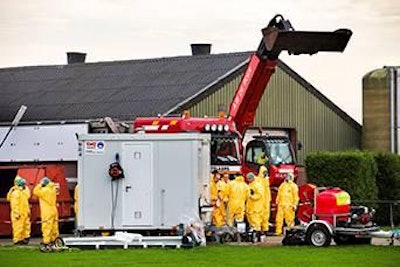
When highly pathogenic avian influenza (HPAI) struck the Netherlands late last year, the country managed to bring the outbreak quickly under control by acting quickly and following comprehensive measures.
On November 14, 2014, birds on a layer farm in the Netherlands started to show symptoms of avian influenza. The symptoms emerged only days after the disease had been diagnosed in the east of Germany. This was no time to take risks.
Samples were to taken for official testing, and the results revealed that highly pathogenic H5N8 avian influenza was present on the Dutch farm. The country’s disease control protocols were immediately brought into action.
All birds on the infected farm were immediately culled and all farms within a 3 kilometer radius screened by the authorities to gain a clear picture of the health status of the area, and to be sure there were no additional infected premises, in which case additional measures would have been necessary.
The government introduced a 72-hour nationwide standstill, prohibiting the transport of all poultry and poultry products – including for export.
Farm to farm movements were minimized. All free-range and organic producers were immediately ordered to move their birds indoors. The combined measures sought to reduce risk and avoid spreading the disease.
In addition to the 3 kilometer zone, a buffer zone with a 10 kilometer radius around the infected farms was created. Inside these zones, the full standstill remained in place for 14-21 days. Exceptions to the rule could only by made under special conditions.
Finally, the country was divided into four sections, and measures adjusted according to need in each zone.
Poultry transport corridors
But farmers do not rear chickens simply for them to be culled mid-cycle. If, however, HPAI emerges, there is little other choice. Culling in the event of an outbreak is mandatory in the Netherlands.
Yet despite the imposition of control measures, only five days after the first outbreak, the disease was diagnosed on a farm in a region close to the original outbreak. It did not stop there: two more outbreaks occurred in a different part of the country shortly afterwards. Again, the same procedures to control the disease were immediately put into practice.
Yet the measures seemed insufficient given that new farms had been found to be positive for HPAI.
The difficulties caused by the “no transport” rule increased dramatically. Grown out broilers could not be taken to slaughter, which led to welfare problems, and supply to and from one particular packing stations was impossible.
To alleviate these problems, the Ministry of Agriculture announced an additional measure. Following strict rules, transport of grown out broilers and eggs could take place through precisely defined corridors between and through these four regions.
Collaborative effort
In addition to the official procedures and measures coordinated and implemented by the Dutch authorities, the poultry industry itself took its own precautions and measures to prevent spreading the disease.
Everyone involved in the industry participated, including farmers’ organizations, feed suppliers, and breeding companies. Together, they advised poultry farmers what to do keep H5N8 out of their flocks.
Their advice may have comprised fairly simple biosecurity measures, but there measures were, nevertheless, absolutely necessary, and their thorough implementation was critical. They included a proper sanitation program, changing clothes and boots time and time again, intense rodent control, maintaining a clean yard, keeping all poultry houses closed, refusing visitor access to farms and keeping pets outside.
Eventually, the Dutch authorities concluded that wild birds had most likely been the disease source, with feces contaminating farms. Free range and organic layer farms were the deemed susceptible, given that birds are allowed to roam outside for much of the time, hence the order to take all birds indoors.
Yet, farms where birds are kept indoors are also susceptible, highlighted by the fact the infected farms kept their birds indoors.
Some compensation
Thanks to swift action following the first appearance of the disease, avian influenza in the Netherlands was limited to three indoor layer flocks, one broiler breeder farm, and one duck rearing farm. Two additional farms were culled preventatively.
The farmers were compensated via the “stamping out fund”, financed jointly by Dutch farmers and the government, hatcheries and by the European Union, which contributed 35 percent of the total payment.
Despite bringing the disease quickly under control however, total direct costs have been around EUR15 million (US$17 million), and this figure only relates to the birds that were culled, and does not include loss of income as a result of the outbreaks. This figure is also thought to be considerable, but will not be compensated for by the fund.
Freedom from infection was declared on January 29, three weeks after the birds on the last infected farm had been culled. From this point, all activity, including exports, could return to normal.
The outbreaks were controlled adequately, but this does not mean that were not lessons to be learned from the disease incursion.
















